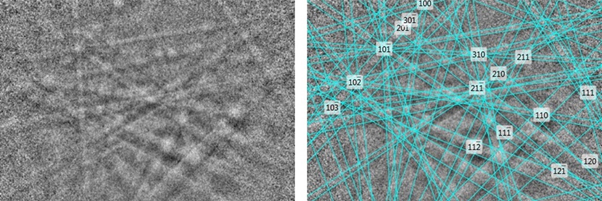
Image: Electron backscatter diffraction of gold
EBSD is based on the principle that the point of incidence of a beam of electrons on a specimen, is the source of electrons diffracted by crystal lattice planes at that point.
Diffracted electrons form Kikuchi patterns that are automatically indexed by an EBSD detector and provide quantitative information on crystal orientations, misorientations and grain boundaries. This information is crucial to understanding the processes that form materials, their deformation history, physical properties (e.g. piezoelectricity and seismic wave velocities), phase transformations and evolution under controlled temperature conditions.

Image: Kikuchi bands generated by electron diffraction from an actinolite crystal (left). Automatic indexing of Kikuchi bands by Oxford Instruments’ AZtec software reveals the crystallographic orientation of the actinolite grain (right).
Liverpool Earth Sciences were one of the first groups to pioneer EBSD in this discipline in the 1990s. We have continued developing EBSD, and EBSD data analysis software through the last 3 decades. We therefore offer a strong expertise in EBSD in the SEM. We work with undergraduate and graduate students, researchers, academics and industry partners. We apply EBSD to Earth materials to understand Earth processes (faulting and earthquakes, mineralisation, carbon capture and storage, volcanic processes, orogenesis and mantle convection). We work closely with Physical Sciences and Engineering on materials discovery for renewable energy resources and the development of solid-state battery technology.
Back to: Scanning Electron Microscopy Shared Research Facility (SEM SRF)